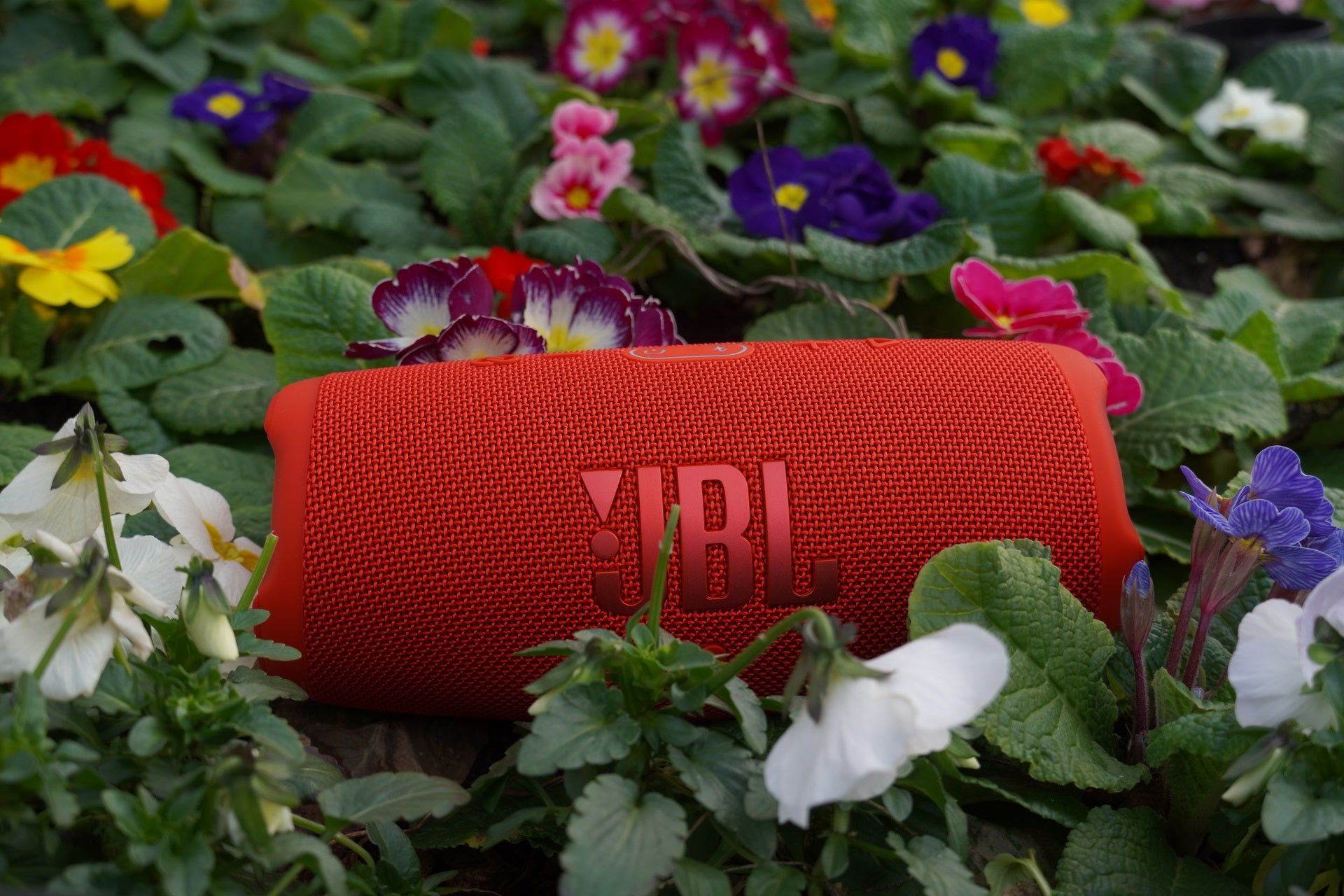Verdict
A fun portable speaker that’s one of the best-sounding efforts in its price bracket. With its tough design, good battery life and powerful sound, the JBL Charge 5 presents itself as a great option for indoor use and outdoors.
Pros
- Big, spacious and powerful sound
- Rugged design
- Can be used as a powerbank
- App support
Cons
- Heavy
- Treble performance could be better
Availability
- UKRRP: £159.99
- USARRP: $179.95
- EuropeRRP: €167.99
- CanadaRRP: CA$239.98
- AustraliaRRP: AU$199.95
-
PartyBoostStereo pair of connect over 100 JBL speakers together -
PowerbankCan charge other devices via its battery -
IP ratingWater, dirt and dust-proof
Introduction
The Charge 5 is part of JBL’s range of larger portable speakers, the option for those who want a bigger sound both indoors and out.
Given it is the fifth iteration of the series you might assume there’s little the Charge 5 could add to its feature set, but while the improvements over the Charge 4 are small, the series remains a massively enjoyable one.
Design
- Tough, rugged, water/dust-proof design
- Heavy
- Wide choice of colours
Imagine a wireless speaker that looks like an American football, and you’d have the Charge 5 – you might even want to play a game of catch with it in the park.
At just under 1kg, you wouldn’t want to fumble the catch lest it hit you square in the face (or any other part of the body). It’s built like the proverbial brick house: durable, heavy and dense. I’ve dropped it down on hills at Greenwich Park from a few feet and I think the ground itself came worse off as the speaker landed with an uncompromising thud.
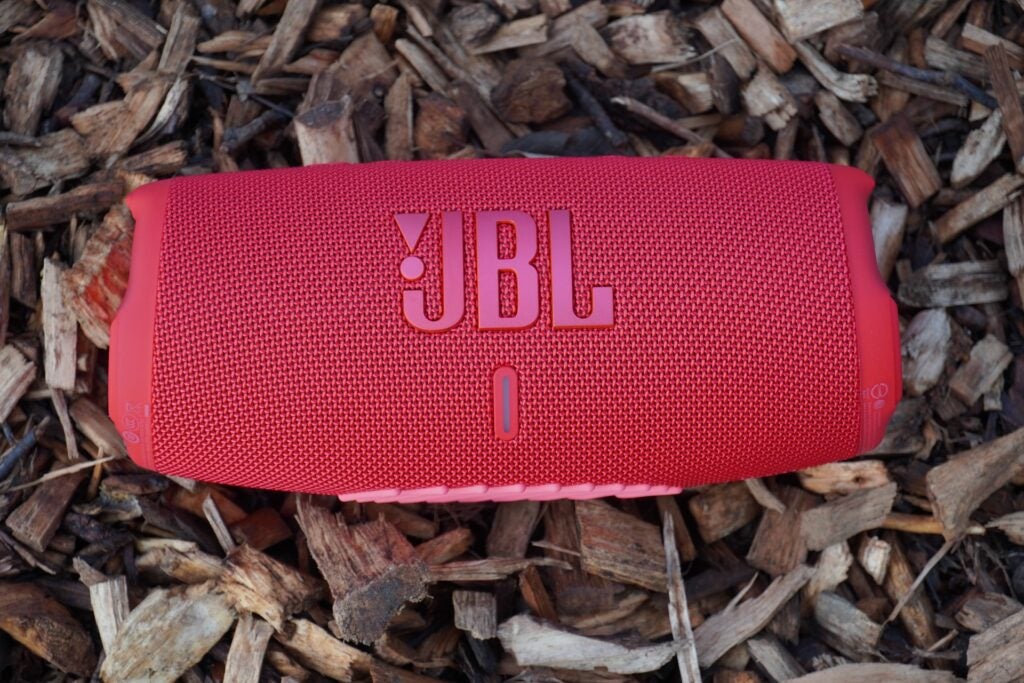
There’s no handle, strap or hang loop to carry but the speaker’s fabric surface is grippy when held in the hand – though you’re going to need a bigger palm to hold the Charge 5 if that’s how you intend to ferry it about.
It comes in an array of colours – blue, white, black, camouflage, grey, green, red and pink – so there’s a generous number of finishes to pick from. As is common with portable speakers, the Charge 5 has a rating of IP67 to defend against ingress of water, dust or dirt (tougher than the Charge 4’s IPX7). If it gets dirty a rinse should clean up any dirt.
Around the back is a USB-C port for charging and the Charge 5 can perform duties as a powerbank to charge a mobile device with a USB-A port concealed beneath a flap. There’s no auxiliary port for connecting a portable player, and while that shouldn’t feel surprising it does surprise me. I half-expect portable speakers of this size to have one.
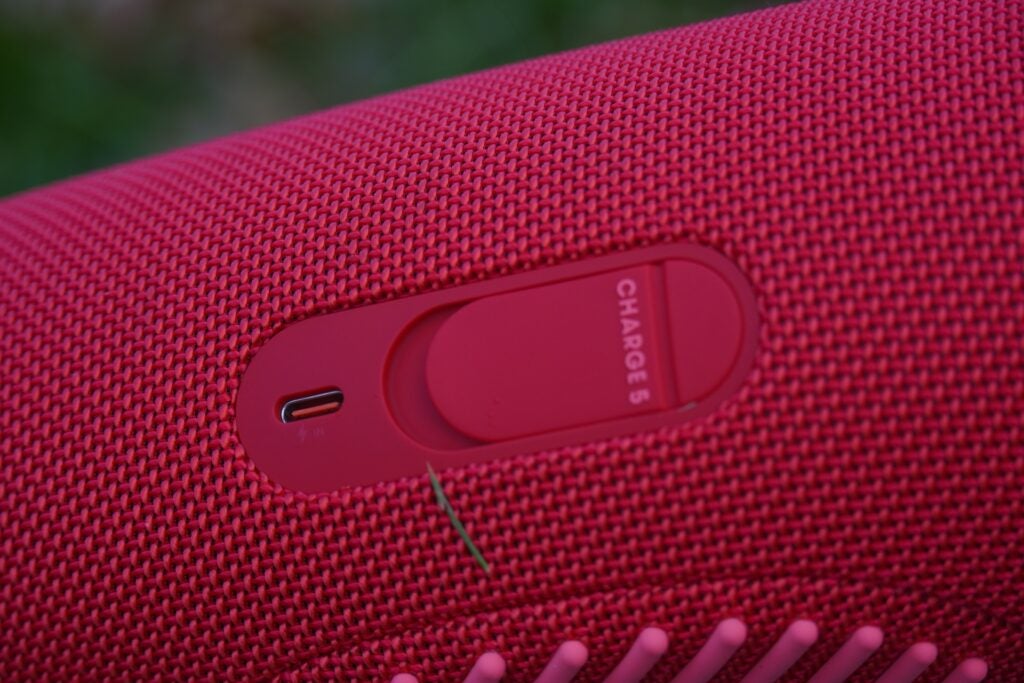
On the speaker’s underside is a rubbery fixture that stops it from rolling over (it is cylindrical in shape after all). On top are volume, playback, power, PartyBoost and Bluetooth buttons, with an audible click that indicates a successful press – all that’s needed is a nudge to operate. One thing to note about the playback control is that while you can skip forward (two presses), you can’t skip back – it’s full steam ahead when it comes to music playlists.
In-between the physical buttons are LED lights that signal when the speaker is powered on and Bluetooth is connected, while below the JBL logo is a beam of light that flickers into life when any of the buttons are pressed, and it’ll also show how much is left in the tank when the speaker is being charged. The lights might not be too helpful during the day, but as the days get shorter, they’ll be a little more helpful to have.
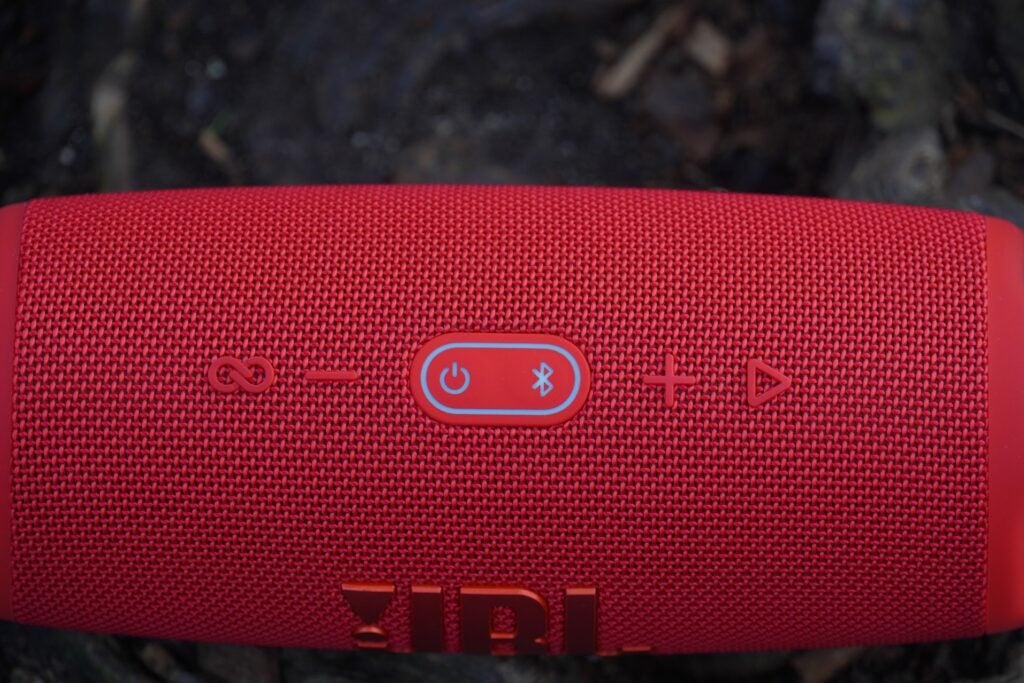
Features
- 20-hour battery life
- PartyBoost for stereo pairing or connecting multiple speakers
- App offers EQ customization, firmware updates
There’s nothing out of the ordinary on the feature side, with the Charge 5 graced with the usual features anyone who’s had a JBL wireless speaker would expect. Battery life is 20 hours, which is around double the Sonos Roam (11) but less than the Marshall Emberton II (30+), for comparison to wireless speakers in the same price bracket. That stamina is dependent on what you’re listening to (bassy tracks will tire the speaker out quicker) and how hard the volume is pushed.
There is no fast charging available and a full charge of the tank from zero takes four hours. At least there’s that option of using the speaker as a powerbank to charge another device when you’re outside.
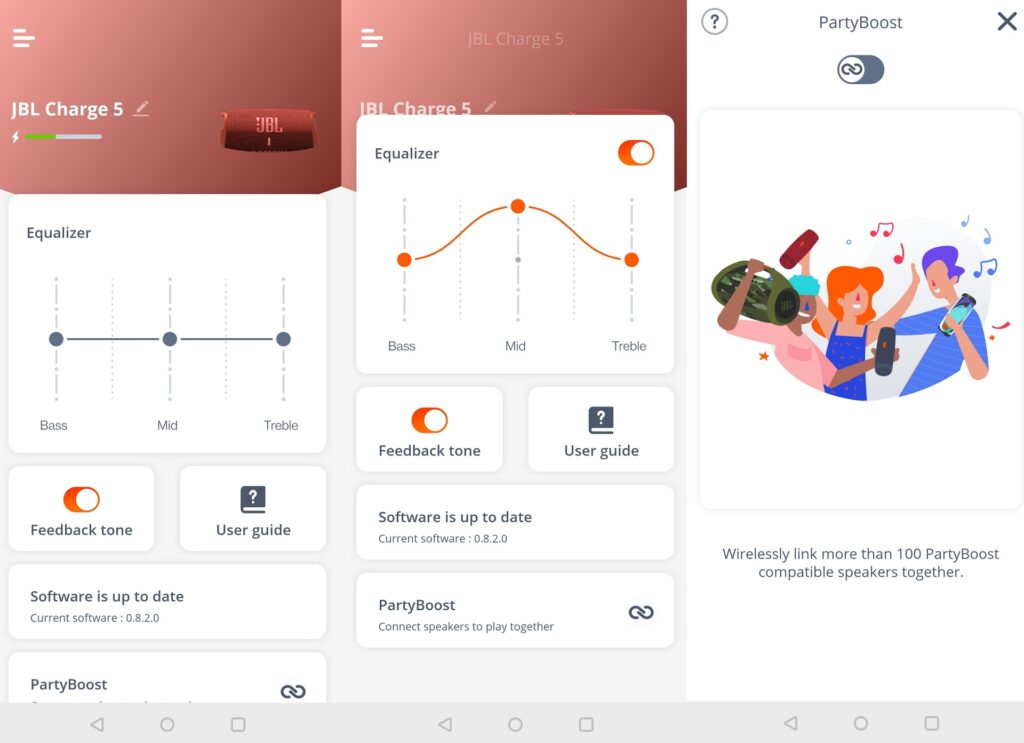
The JBL Portable app presents a sprinkling of features but nothing too in-depth. There’s a three-band equalizer for customizing audio, the name of the speaker changed, or battery levels checked its battery life. Firmware updates and the ability to enable JBL’s PartyBoost functionality make up the rest of the features.
PartyBoost allows for pairing the Charge 5 to another for stereo listening as well as pressing allowing the speaker to wirelessly chain more than 100 JBL PartyBoost compatible speakers together. In case you’re interested in attempting a Guinness Book of Records, the world record is 1000 JBL Flip 4 speakers.
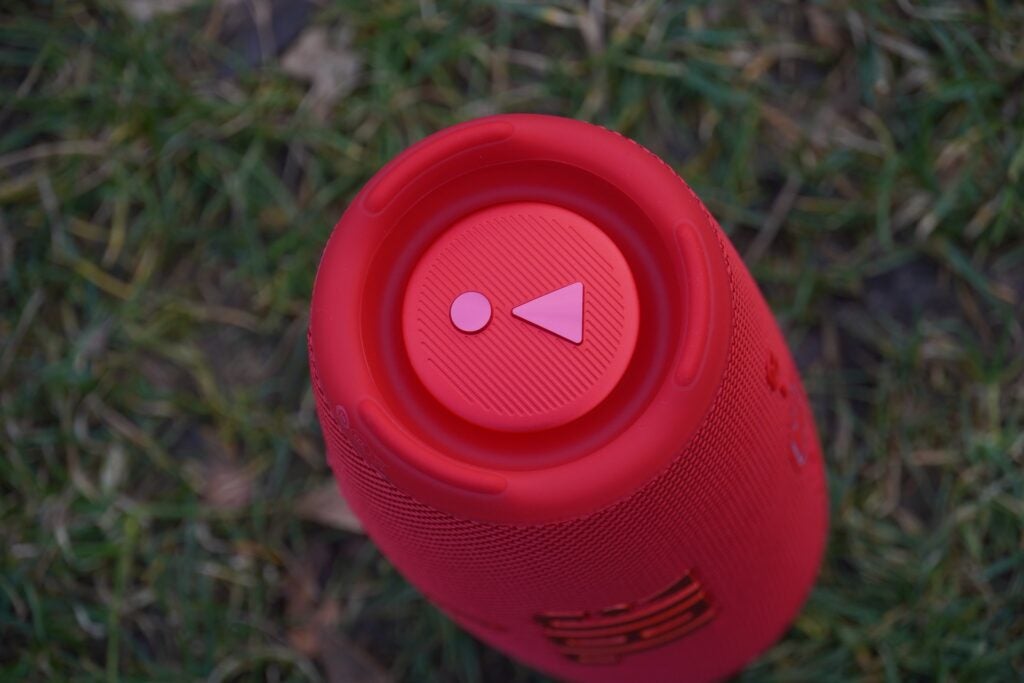
With Bluetooth 5.1 connectivity the strength of the connection is reliable over long distances. Playing The Beatles Hey Jude at full blast and walking from one end of a garden to the other and the signal didn’t break up once, which was better than the Emberton II fared under the same conditions.
Sound Quality
- Big, spacious performance
- Fun and energetic flow
- Big bass even at lower volumes
My first assumption before listening to the speaker was that it would be heavily bassy, but it turns out that while the Charge 5 does produce large amounts of bass, it’s also it’s a clear, concise and impressively powerful performer, easily vaulting itself into the category of the best-sounding speakers around the £150 mark.
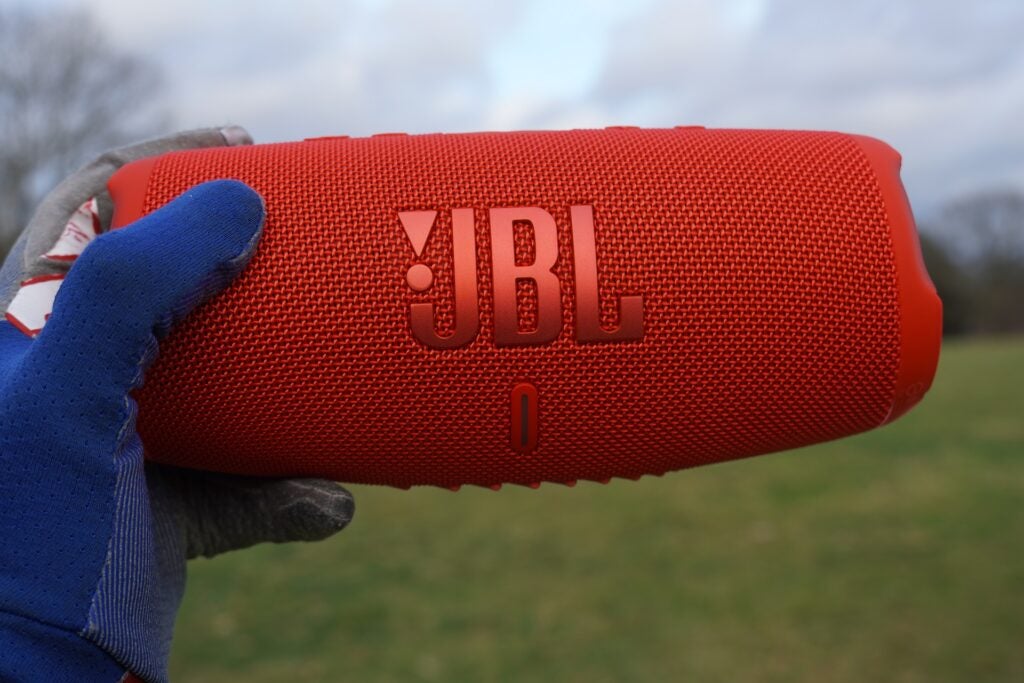
The Charge 5 presents a clear and well-defined soundstage with every track I pass through it. There is a great level of clarity to Childish Gambino’s vocals in This is America, as well as a good amount of width to the soundstage partnered with good levels of separation between the instruments and vocals.
The levels of clarity, detail and separation help to ensure the track didn’t come across as muddy or unclear as it rose to a crescendo. I found the performance – described by JBL as its ‘Original Pro Sound’ – to be quite mature for a portable speaker, closer in tone to the Sonos Roam than the richness of the Sony SRS-XG300.
The width of the soundstage is the same as the speaker, but it can sound bigger when the volume is raised. Immanuel Wilkins’ Grace and Mercy builds into a fairly dense piece with its percussive and string elements, but the Charge 5 gives it space to breathe to hear the piano, drums, cymbal crashes and upright bass without them coalescing into one amorphous blob.
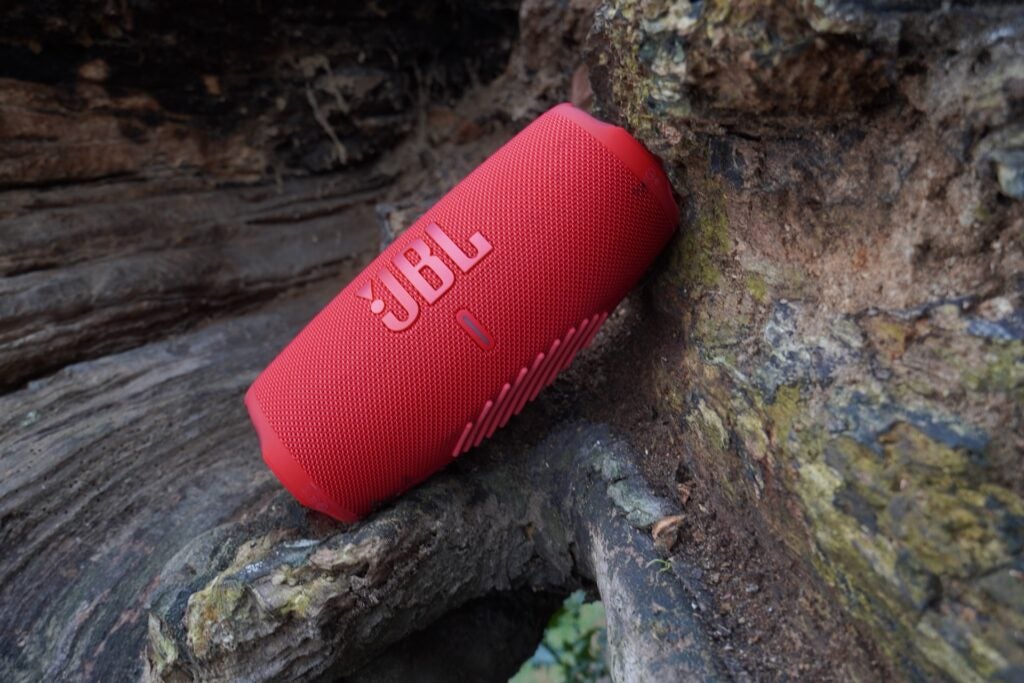
With Alex Isley and Jack Dine’s Love Again, it puts forward a weighty bass performance (thanks to those dual pumping bass radiators), and it does so without imposing on the midrange. Vocals take the lead in tracks, described in a big fashion but at times this is to the detriment of background elements as they recede further away in the mix. This especially noticeable with busier-sounding tracks.
I’d say the JBL is solidly balanced but if I had a criticism, it would be the Charge 5 isn’t the brightest-sounding speaker. While high frequency notes are clear, there’s an aspect where they sound dulled despite having a separate tweeter to cover those higher frequencies.
It’s a slight knock against the Charge 5’s performance but not enough to put it off its stride. I like the dynamism it offers in both a small sense (the variation of notes) and at a larger scale as it represents the difference between quiet and loud. With Iggy Pop’s The Passenger it shows good rhythmic ability, the crisp cymbal crashes hit with energy and there’s a nice, engaging sense of momentum that propels the track forward. It’s a consistently energetic and fluid performer with music.
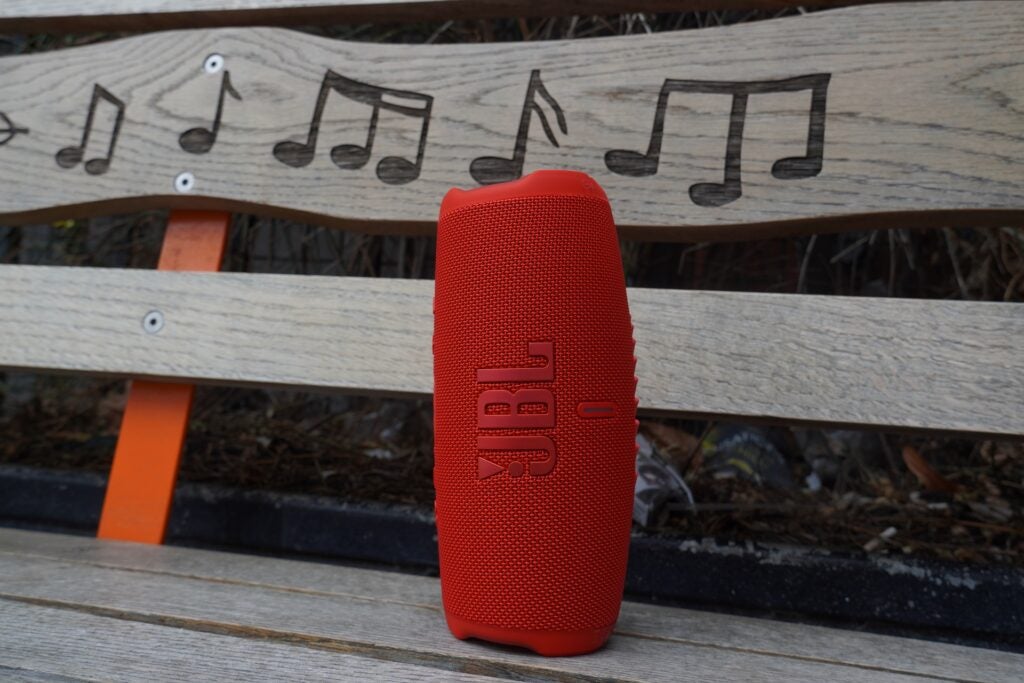
It can also go very loud, louder than the bigger SRS-XG300. Even at lower volumes (well below 50%) it handles bass with punch and power that I wouldn’t expect, pitching itself as a portable speaker not just for the outdoors but for use in bigger rooms in the home.
With The Beatles’ Hey Jude ratcheted up to full volume and there’s no audible distortion or sense of strain, the sound of Paul McCartney’s voice easily fills the garden I’m in. It does appear the digital signal processing (DSP) kicks in and nerfs the bass performance at higher volumes, which is understandable.
The Charge 5 also has a directional approach to sound – any listener will want to sit towards the speaker and not behind or to its sides as its performance can sound diminished. The size of its sound at higher volumes does help to combat that issue though.
Latest deals
Should you buy it?
For fun-sized sound in portable form: A big spacious performance delivered with lots of power and energy, if you feel portable speakers are lacking for bass then the Charge 5 is the answer
If you want a more ‘portable speaker’: The Charge 5 is big and heavy and doesn’t come with a handle or loop to carry or attach to a bag, which is worth bearing in mind when transporting it.
Final Thoughts
The Charge 5 is a fun portable speaker with a big sound and plenty of bass. It’s an energetic effort for indoor use and outdoor use, its rugged design means it can survive plenty of hard knocks and its battery life means it’ll last a fair while – as long as you’re not blasting songs at full volume all the time.
This is a portable speaker with a fun outlook, and sound quality to match. Its ability to go very loud makes it a fine choice for parties or big groups, and for those who find portable speakers lacking in the bass department, you’ll appreciate what the Charge 5 brings to the table.
How we test
We test every wireless speaker we review thoroughly over an extended period of time. We use industry-standard tests to compare features properly. We’ll always tell you what we find. We never, ever, accept money to review a product.
Find out more about how we test in our ethics policy.
Tested across several months
Tested in multiple environments
Tested with real world use
FAQs
There is support for an audio equaliser in the JBL Portable app for the Charge 5.
Sustainability
Trusted Reviews’ holds the fact that global warming is not a myth as a core value and will continuously endeavour to help protect our planet from harm in its business practices.
As part of this mission, whenever we review a product we send the company a series of questions to help us gauge and make transparent the impact the device has on the environment.
We currently haven’t received answers to the questions on this product, but will update this page the moment we do. You can see a detailed breakdown of the questions we ask and why in our sustainability info page
Jargon buster
Bluetooth
Bluetooth – named after 10th-century Danish king Harald Bluetooth who united Denmark’s tribes into a single kingdom – is a method of wireless transmission that allows for the exchange of data between devices over short distances.
IP rating
An abbreviation for ‘Ingress Protection Code’, which lets you know to what extent a device might be waterproof or dustproof.
Verdict
A fun portable speaker that’s one of the best-sounding efforts in its price bracket. With its tough design, good battery life and powerful sound, the JBL Charge 5 presents itself as a great option for indoor use and outdoors.
Pros
- Big, spacious and powerful sound
- Rugged design
- Can be used as a powerbank
- App support
Cons
- Heavy
- Treble performance could be better
Availability
- UKRRP: £159.99
- USARRP: $179.95
- EuropeRRP: €167.99
- CanadaRRP: CA$239.98
- AustraliaRRP: AU$199.95
-
PartyBoostStereo pair of connect over 100 JBL speakers together -
PowerbankCan charge other devices via its battery -
IP ratingWater, dirt and dust-proof
Introduction
The Charge 5 is part of JBL’s range of larger portable speakers, the option for those who want a bigger sound both indoors and out.
Given it is the fifth iteration of the series you might assume there’s little the Charge 5 could add to its feature set, but while the improvements over the Charge 4 are small, the series remains a massively enjoyable one.
Design
- Tough, rugged, water/dust-proof design
- Heavy
- Wide choice of colours
Imagine a wireless speaker that looks like an American football, and you’d have the Charge 5 – you might even want to play a game of catch with it in the park.
At just under 1kg, you wouldn’t want to fumble the catch lest it hit you square in the face (or any other part of the body). It’s built like the proverbial brick house: durable, heavy and dense. I’ve dropped it down on hills at Greenwich Park from a few feet and I think the ground itself came worse off as the speaker landed with an uncompromising thud.

There’s no handle, strap or hang loop to carry but the speaker’s fabric surface is grippy when held in the hand – though you’re going to need a bigger palm to hold the Charge 5 if that’s how you intend to ferry it about.
It comes in an array of colours – blue, white, black, camouflage, grey, green, red and pink – so there’s a generous number of finishes to pick from. As is common with portable speakers, the Charge 5 has a rating of IP67 to defend against ingress of water, dust or dirt (tougher than the Charge 4’s IPX7). If it gets dirty a rinse should clean up any dirt.
Around the back is a USB-C port for charging and the Charge 5 can perform duties as a powerbank to charge a mobile device with a USB-A port concealed beneath a flap. There’s no auxiliary port for connecting a portable player, and while that shouldn’t feel surprising it does surprise me. I half-expect portable speakers of this size to have one.

On the speaker’s underside is a rubbery fixture that stops it from rolling over (it is cylindrical in shape after all). On top are volume, playback, power, PartyBoost and Bluetooth buttons, with an audible click that indicates a successful press – all that’s needed is a nudge to operate. One thing to note about the playback control is that while you can skip forward (two presses), you can’t skip back – it’s full steam ahead when it comes to music playlists.
In-between the physical buttons are LED lights that signal when the speaker is powered on and Bluetooth is connected, while below the JBL logo is a beam of light that flickers into life when any of the buttons are pressed, and it’ll also show how much is left in the tank when the speaker is being charged. The lights might not be too helpful during the day, but as the days get shorter, they’ll be a little more helpful to have.

Features
- 20-hour battery life
- PartyBoost for stereo pairing or connecting multiple speakers
- App offers EQ customization, firmware updates
There’s nothing out of the ordinary on the feature side, with the Charge 5 graced with the usual features anyone who’s had a JBL wireless speaker would expect. Battery life is 20 hours, which is around double the Sonos Roam (11) but less than the Marshall Emberton II (30+), for comparison to wireless speakers in the same price bracket. That stamina is dependent on what you’re listening to (bassy tracks will tire the speaker out quicker) and how hard the volume is pushed.
There is no fast charging available and a full charge of the tank from zero takes four hours. At least there’s that option of using the speaker as a powerbank to charge another device when you’re outside.

The JBL Portable app presents a sprinkling of features but nothing too in-depth. There’s a three-band equalizer for customizing audio, the name of the speaker changed, or battery levels checked its battery life. Firmware updates and the ability to enable JBL’s PartyBoost functionality make up the rest of the features.
PartyBoost allows for pairing the Charge 5 to another for stereo listening as well as pressing allowing the speaker to wirelessly chain more than 100 JBL PartyBoost compatible speakers together. In case you’re interested in attempting a Guinness Book of Records, the world record is 1000 JBL Flip 4 speakers.

With Bluetooth 5.1 connectivity the strength of the connection is reliable over long distances. Playing The Beatles Hey Jude at full blast and walking from one end of a garden to the other and the signal didn’t break up once, which was better than the Emberton II fared under the same conditions.
Sound Quality
- Big, spacious performance
- Fun and energetic flow
- Big bass even at lower volumes
My first assumption before listening to the speaker was that it would be heavily bassy, but it turns out that while the Charge 5 does produce large amounts of bass, it’s also it’s a clear, concise and impressively powerful performer, easily vaulting itself into the category of the best-sounding speakers around the £150 mark.

The Charge 5 presents a clear and well-defined soundstage with every track I pass through it. There is a great level of clarity to Childish Gambino’s vocals in This is America, as well as a good amount of width to the soundstage partnered with good levels of separation between the instruments and vocals.
The levels of clarity, detail and separation help to ensure the track didn’t come across as muddy or unclear as it rose to a crescendo. I found the performance – described by JBL as its ‘Original Pro Sound’ – to be quite mature for a portable speaker, closer in tone to the Sonos Roam than the richness of the Sony SRS-XG300.
The width of the soundstage is the same as the speaker, but it can sound bigger when the volume is raised. Immanuel Wilkins’ Grace and Mercy builds into a fairly dense piece with its percussive and string elements, but the Charge 5 gives it space to breathe to hear the piano, drums, cymbal crashes and upright bass without them coalescing into one amorphous blob.

With Alex Isley and Jack Dine’s Love Again, it puts forward a weighty bass performance (thanks to those dual pumping bass radiators), and it does so without imposing on the midrange. Vocals take the lead in tracks, described in a big fashion but at times this is to the detriment of background elements as they recede further away in the mix. This especially noticeable with busier-sounding tracks.
I’d say the JBL is solidly balanced but if I had a criticism, it would be the Charge 5 isn’t the brightest-sounding speaker. While high frequency notes are clear, there’s an aspect where they sound dulled despite having a separate tweeter to cover those higher frequencies.
It’s a slight knock against the Charge 5’s performance but not enough to put it off its stride. I like the dynamism it offers in both a small sense (the variation of notes) and at a larger scale as it represents the difference between quiet and loud. With Iggy Pop’s The Passenger it shows good rhythmic ability, the crisp cymbal crashes hit with energy and there’s a nice, engaging sense of momentum that propels the track forward. It’s a consistently energetic and fluid performer with music.

It can also go very loud, louder than the bigger SRS-XG300. Even at lower volumes (well below 50%) it handles bass with punch and power that I wouldn’t expect, pitching itself as a portable speaker not just for the outdoors but for use in bigger rooms in the home.
With The Beatles’ Hey Jude ratcheted up to full volume and there’s no audible distortion or sense of strain, the sound of Paul McCartney’s voice easily fills the garden I’m in. It does appear the digital signal processing (DSP) kicks in and nerfs the bass performance at higher volumes, which is understandable.
The Charge 5 also has a directional approach to sound – any listener will want to sit towards the speaker and not behind or to its sides as its performance can sound diminished. The size of its sound at higher volumes does help to combat that issue though.
Latest deals
Should you buy it?
For fun-sized sound in portable form: A big spacious performance delivered with lots of power and energy, if you feel portable speakers are lacking for bass then the Charge 5 is the answer
If you want a more ‘portable speaker’: The Charge 5 is big and heavy and doesn’t come with a handle or loop to carry or attach to a bag, which is worth bearing in mind when transporting it.
Final Thoughts
The Charge 5 is a fun portable speaker with a big sound and plenty of bass. It’s an energetic effort for indoor use and outdoor use, its rugged design means it can survive plenty of hard knocks and its battery life means it’ll last a fair while – as long as you’re not blasting songs at full volume all the time.
This is a portable speaker with a fun outlook, and sound quality to match. Its ability to go very loud makes it a fine choice for parties or big groups, and for those who find portable speakers lacking in the bass department, you’ll appreciate what the Charge 5 brings to the table.
How we test
We test every wireless speaker we review thoroughly over an extended period of time. We use industry-standard tests to compare features properly. We’ll always tell you what we find. We never, ever, accept money to review a product.
Find out more about how we test in our ethics policy.
Tested across several months
Tested in multiple environments
Tested with real world use
FAQs
There is support for an audio equaliser in the JBL Portable app for the Charge 5.
Sustainability
Trusted Reviews’ holds the fact that global warming is not a myth as a core value and will continuously endeavour to help protect our planet from harm in its business practices.
As part of this mission, whenever we review a product we send the company a series of questions to help us gauge and make transparent the impact the device has on the environment.
We currently haven’t received answers to the questions on this product, but will update this page the moment we do. You can see a detailed breakdown of the questions we ask and why in our sustainability info page
Jargon buster
Bluetooth
Bluetooth – named after 10th-century Danish king Harald Bluetooth who united Denmark’s tribes into a single kingdom – is a method of wireless transmission that allows for the exchange of data between devices over short distances.
IP rating
An abbreviation for ‘Ingress Protection Code’, which lets you know to what extent a device might be waterproof or dustproof.


















